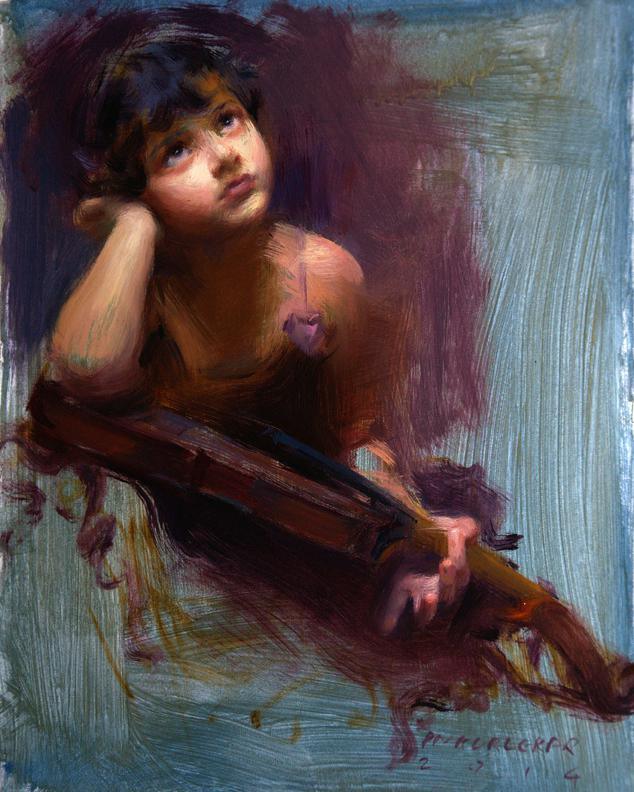Introducing the Keys Behind Expressive Figurative Oil Painting Styles
Introducing the Keys Behind Expressive Figurative Oil Painting Styles
Blog Article
The Duty of Feeling and Expression in Metaphorical Oil Paint: An In-Depth Analysis of Topic and Make-up
The interplay of emotion and expression in figurative oil painting functions as a critical lens with which one can analyze the intricate partnership between subject and composition. Artists harness different strategies, from shade selection to brushstroke characteristics, to grow psychological vibration within their works. This nuanced orchestration not only shapes audience understanding yet also invites a deeper query into how these elements integrate to mirror the intricacies of human experience. As we explore this abundant surface, one should consider just how particular study brighten the wider ramifications of these creative choices.
Understanding Emotion in Art
Emotion in art functions as an effective conduit for expression, allowing artists to share complicated sensations through their job. In figurative oil paint, this emotional depth is frequently represented with the depiction of the human figure, recording the nuances of human experience. The option of subject issue, shade combination, and brushwork all add to the emotional vibration of a piece.
Artists frequently draw upon personal experiences, societal concerns, or global motifs to evoke feelings in the viewer. For circumstances, a portrait may show susceptability, while a dynamic figure in movement can signify freedom or chaos. These psychological strings connect the viewer to the artwork, promoting a dialogue that transcends the aesthetic tool.
Furthermore, the interaction in between light and shadow can enhance emotional strength, leading the viewer's stare and accentuating particular elements within the composition. Using appearance in oil painting even more includes layers of complexity, inviting a tactile action that improves the emotional experience. Generally, understanding feeling in art is vital for valuing the nuances that characterize figurative oil painting, as it changes simple representation into an extensive exploration of the human problem.
Crucial Element of Make-up
In the world of figurative oil painting, the composition functions as the underlying framework that arranges aesthetic elements and enhances the emotional narrative. Important components of structure consist of equilibrium, comparison, prime focus, and rhythm, each adding to the overall effect of the art work.
Balance describes the circulation of visual weight within the paint, which can be accomplished via unbalanced or in proportion arrangements. A healthy make-up gives stability, permitting the customer to engage with the item sympathetically - figurative oil painting. Contrast, on the various other hand, involves comparing different elements, such as dark and light or warm and cool shades, to lead the viewer's eye and stimulate psychological actions
The centerpiece is vital, as it guides interest to one of the most substantial component of the painting, commonly highlighting the emotional core of the story. Via methods like shade saturation or positioning, artists can stress this location successfully. Finally, rhythm concern the repeating of aspects, creating a sense of motion and circulation throughout the composition. By skillfully integrating these crucial elements, artists can craft engaging and psychologically powerful metaphorical oil paints that astound and involve their target market.
Subject and Its Effect
Subject issue plays an essential role in figurative oil painting, as it not only works as the structure for the narrative but also forms the customer's interpretation and psychological interaction with the art work. The choice of subject-- be it a singular figure, a team dynamic, or a thematic representation-- straight affects the emotional ambience conveyed to the audience.

For instance, portraits often stimulate individual connections, exposing the details of human expression and character, while scenes showing public tasks can create a sense of belonging or fond memories. Moreover, the historic and social context of the subject enriches the customer's understanding, triggering deeper representations on social norms, worths, and the human problem.
Different subjects also produce varying degrees of engagement; a significant problem illustrated with numbers in tension might generate feelings of anxiety or empathy, while tranquil landscapes can conjure up harmony and reflection. Inevitably, the influence of subject matter in figurative oil paint is profound, as it functions as a conduit for emotional vibration, assisting the visitor's reaction and analysis, and cultivating a connection between the observer and the artwork. This interplay is vital for the effective interaction of the musician's intent.
Techniques for Evoking Sensations
The effectiveness of metaphorical oil click site paint in communicating emotions is considerably affected by the techniques employed by the musician. Among the most crucial approaches is making use of color concept, where the strategic option of hues can stimulate details emotional feedbacks. Cozy shades, such as reds and oranges, frequently evoke sensations of enthusiasm published here or hostility, while cooler tones like blues and eco-friendlies have a tendency to evoke calmness or sadness.
An additional crucial strategy is the adjustment of light and darkness, recognized as chiaroscuro. This technique boosts the three-dimensionality of figures, developing remarkable contrasts that can escalate emotional deepness. The placement of light can assist visitors' feelings, highlighting particular elements of the structure.
Brushwork additionally plays a crucial function; loose, expressive strokes can convey energy and spontaneity, whereas smoother techniques may suggest tranquility or accuracy. The setup of topics within the make-up can affect psychological impact. Close distance can suggest intimacy, while range might indicate isolation.
Inevitably, the combination of these strategies enables musicians to craft narratives that resonate with the customer, changing a mere visual experience into an expressive psychological trip. - figurative oil painting

Study of Noteworthy Functions
Examining notable works of figurative oil paint reveals just how different methods are utilized to stimulate effective feelings. One excellent instance is Edvard Munch's "The Scream," where the altered figure and swirling history communicate existential dread. Munch's use color-- deep blues and dazzling oranges-- intensifies the psychological impact, showcasing just how palette options can form viewer experience.
Another significant job is Pablo Picasso's "Les Demoiselles d'Avignon." Below, strong brushstrokes and fragmented forms show a troubled psychological landscape, challenging standard depictions of the female number. Picasso's ingenious composition not just catches the visitor's focus yet additionally invites contemplation on themes of identity and sexuality.
In Addition, Frida Kahlo's "Both Fridas" uses an emotional exploration of duality and self-identity. The contrasting figures, linked by a common heart, exemplify Kahlo's emotional deepness and personal narrative. figurative oil painting. Her meticulous interest to detail and symbolic aspects offer to engage viewers on a visceral degree
These study highlight the profound link between emotion and structure in figurative oil painting, disclosing how musicians harness technique to connect complicated feelings and stories that reverberate across time and society.

Final Thought
Finally, the interplay of emotion and expression in figurative oil paint considerably boosts the visitor's experience and analysis of the art work. Via a mindful choice of topic and compositional strategies, musicians communicate profound stories that resonate on both individual and global levels. The application of color brushwork, concept, and chiaroscuro additional intensifies emotional depth, transforming each canvas into an effective reflection of the complexities of the human experience.
In figurative oil painting, this emotional deepness is often portrayed through the useful reference representation of the human number, capturing the subtleties of human experience.Additionally, the interplay in between light and shadow can intensify psychological intensity, directing the visitor's stare and drawing interest to particular components within the structure. The use of texture in oil painting better includes layers of complexity, welcoming a responsive action that enhances the psychological experience.The focal point is crucial, as it guides attention to the most substantial component of the paint, often highlighting the emotional core of the story. Ultimately, the influence of subject matter in figurative oil painting is profound, as it serves as a channel for emotional vibration, assisting the viewer's response and interpretation, and promoting a link between the art work and the observer.
Report this page